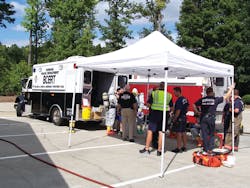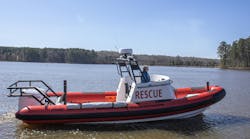Durham, NC, established in 1869 and known as the “City of Medicine,” is in the north-central part of the state on Interstates 85 and 40. The city is part of the “Research Triangle,” or “Triangle,” an area encompassing three major universities – Duke in Durham, the University of North Carolina in Chapel Hill and North Carolina State in Raleigh.
Because of the close proximity of Raleigh and Durham, the term Raleigh-Durham is often used for the geographical area and they share the Raleigh-Durham International Airport. Durham has a population of approximately 225,093 in an area of 69 square miles. Durham’s rich history includes tobacco companies, the first mill to produce denim and the world’s largest hosiery maker. Today, it is home to the world’s largest university-related research park, Triangle Park.
Within the City of Durham, both the fire and police departments provide hazardous materials and biological-chemical terrorism response and they work together on many emergency responses. The departments also work closely with the Durham County Emergency Management Agency and the Public Health Department. Durham Police and Fire department teams train together monthly. All non-criminal hazmat calls such as hydrocarbon fuel spills along with other types of hazardous materials incidents are dispatched solely to the Durham Fire Department.
If a call is suspicious in nature, such as for white-powder incidents or suspicious packages, police respond for the initial investigation. Once the investigating officer determines that a biological-chemical hazmat response is needed, the police department’s Biological-Chemical Emergency Response Team (BCERT) is called. Requests are made through the police department watch commander, who notifies the BCERT coordinator.
While enroute, the BCERT requests a full hazmat response from the Durham Fire Department. Such a fire department response includes Hazmat Engines 3 and 13, Hazmat 13, a district engine and ladder, a squad company, a paramedic ambulance and a battalion chief. Once on scene, recon operations are conducted with one police officer and two firefighters and evidence is collected by two police officers and one firefighter. Because of the requirements of the evidence chain of custody, the police officers deal with evidence while the firefighter monitors environmental conditions. Decontamination can be conducted by either team, but is usually assigned to the fire department because it typically has more personnel on scene. BCERT Coordinator Tim Westcott, a police department investigator, said splitting duties lets fire and police personnel work together in training and on calls.
The BCERT is part of the police department’s Operations Bureau. The team was formed in early 1999 amid concerns about “Y2K” issues and the growing threat of weapons of mass destruction (WMDs) worldwide. Initially, the team was composed of two technicians who also performed other functions in the department. White-powder incidents, which peaked in October 2001, led to the technicians becoming full time with the addition of a full-time investigator to the team. Currently, the team is composed of a full-time coordinator and eight reserve officers who respond to hazmat incidents as a secondary function.
Covering the City of Durham as well as Durham, Grandville, Person, Vance and Wake counties, the BCERT responds to an average of 30 incidents a year. Team members have extensive training at the Center for Domestic Preparedness in Anniston, AL; radiological training at the Nevada Test Site near Las Vegas; explosives training at New Mexico Tech at Socorro; and additional WMD training at the Dugway Proving Grounds near Salt Lake City, UT.
Most equipment and protective clothing is purchased with grants or money confiscated from criminal activity. Chemical protective clothing includes Level A DuPont Tychem TK 650 and Level B Blauer Multi-Threat Suit, Blauer XRT ensemble and Lakeland Tychem F coveralls. Breathing protection is provided by Survivair Panther self-contained breathing apparatus (SCBA) with in-mask communications and North Safety escape hoods. Cooling vests are used at hot-weather incidents. Chemical and biological monitors carried include Smiths Detection HazMatID 360, RespondeR RCI (Raman Chemical Identifier) and LCD (Lightweight Chemical Detector) 3.3 as well as M8, M9 and 256 test papers and KI (potassium iodide), pH and water paper. Biological-only monitoring includes ADVNT PS-5T Pro Strips, Alexeter RAID (Rapid Assessment Initial Detection) 8 and BioCheck 20/20 powdered screening test kit. Trace explosives and narcotics are detected with the Smiths Detection MMTD (Multi-Mode Threat Detector). Radiation instruments include the Ludlum 2241 survey meter and Canberra UltraRadiac radiation monitor. Air monitoring is accomplished with the RAE Systems MultiRAE Pro Wireless portable multi-threat monitor for oxygen (O2), carbon monoxide (CO) and hydrogen sulfide (H2S), PID PPB 10.6 lower explosive limit (LEL) and gamma sensor; MSA Sirius multi-gas detector for O2, CO and H2S; and MSA AltAir 4 four-gas monitor for O2, CO, H2S and LEL. Other equipment carried includes evidence-collection kits for chemical and biological materials and a decontamination shower and related equipment.
Thanks to Investigator Tim Westcott, the BCERT coordinator, for his help in preparation of this column. (He was a third-generation volunteer firefighter and captain in the Brockport, NY, Fire Department before moving to Durham.) Thanks also to other Durham police officials for their assistance. For additional information about the BCERT, contact Westcott at [email protected] or (919)560-4454, ext. 29344.






